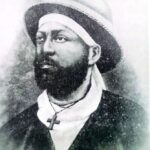DAWSON, KATE
- 3 Min Read
Kate Dawson (lived in the 19th century), or Kate Swanzy, whose African name was Efua Ketse, was a merchant, philanthropist, and patriot who became prominent in Cape Coast and its vicinity.

PHOTO CAPTION: Dawson Kate. SOURCE: Everythingfante.org
She was the daughter of Sarah Adadzewa, a member of the royal family of Komenda, the fishing port 15 mi (24 km) west of Cape Coast, who came to live in Cape Coast in the 19th century. On her mother’s death, Kate Dawson succeeded her. She engaged in commerce, invested in buildings, and became very prosperous. Some of her buildings in Cape Coast were Fortgate House, Gothic House, Government House, and the houses on a part of Cape Coast known as Dawson Hill.
Apart from her business ventures, she also gave financial support to churches and to needy individuals. She was, however, a strong opponent of the poll tax, and wrote to the British governor, Henry Connor (who held office in 1855) about her decision to pay the tax under protest, to avoid punishment. She married Frank Swanzy, of the well-known English trading firm of F. and A. Swanzy Limited, and through joint trading acquired vast landed property in and around Cape Coast.

Fort William, located on Dawson’s Hill in Cape Coast
She financed the African rulers of Cape Coast, and some of the states of the Gold Coast which sought her aid. She also gave some of her land to families which needed land for settlement. After one of the crises which arose between the British and the Asante, she agreed to the request of Stephen John Hill, the British governor in 1851-1854, for land in Kotokoraba (a part of Cape Coast) to settle the demobilised soldiers. On another occasion, she bought off a threatened Asante invasion of Cape Coast by paying the Asante the £486-worth of gold that they demanded. Her action on this occasion won her the title of “Ebum”, meaning “The Breaker of the Asantehene’s Mighty Balance”, since nobody had expected such a large amount of gold to be owned by a woman.

Gothic House
When, in 1873, the Asante again threatened to invade Cape Coast, she and seven African ladies urged the governor of the day to help the citizens, and offered to pay for a military expedition against Asante. This led to the expedition against Asante in the Sagrenti war of 1873-1874, described by G. A. Henty in ‘The March to Coomasie’ (1874).
S. K. OTOO




